4 ways locally grown food can create more jobs for the Ann Arbor area
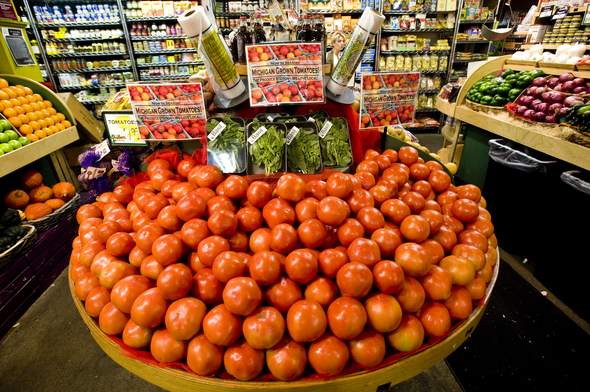
The Produce Station, a local seller of fruits, vegetables and plants, went from 55 employees in 2010 to 65 in 2011. The retailer is benefiting directly from a surge of interest in locally grown products, such as the Michigan-grown tomatoes shown above.
Joseph Tobianski I AnnArbor.com
Powered by the “locavore” movement, food is quickly becoming a source of innovation and job creation for the Ann Arbor area.
Locally grown, processed and sold food offers a significant economic opportunity for Washtenaw County, local officials agree.
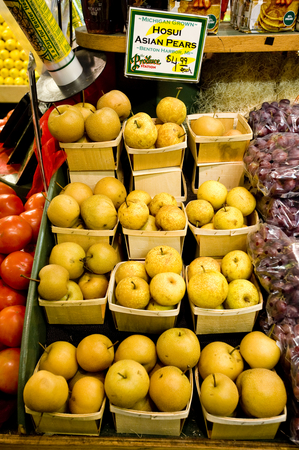
Michigan grown hosui Asian pears are stacked on a table at the The Produce Station on South State Street.
Joseph Tobianski I AnnArbor.com
The emergence of businesses like outdoor food courtyard Mark’s Carts — a downtown Ann Arbor destination where small-scale restaurateurs are trying out new concepts — and the growth of long-time local institutions like the Produce Station highlight the immediate benefits of an increase in local food.
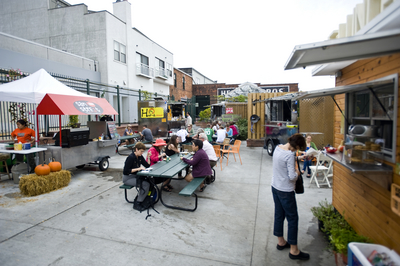
Mark's Carts, a new outdoor food courtyard in Ann Arbor, is acting as a food incubator of sorts. Now, Washtenaw County plans to launch a commercial kitchen incubator in Ypsilanti.
Joseph Tobianski I AnnArbor.com
For Washtenaw County, food has already been creating jobs. From 2009 to 2013, local restaurants and bars were projected to add 1,190 jobs, according to an economic study and forecast released in March by the University of Michigan. About 12,000 people work for restaurants or bars in the county today.
The Michigan Department of Agriculture and Rural Development believes the state’s agri-food industry can grow to $100 billion.
Industry officials say that could involve several new initiatives, including:
1. New job training programs and opportunities. Washtenaw County government leaders are currently formulating a plan to launch a commercial kitchen incubator modeled after a concept that came out of a recommendation by the Food Systems Economic Partnership.
The incubator will provide food entrepreneurs a chance to try out their ideas in a commercial environment, said Mary Jo Callan, community development director for Washtenaw County. The operation is likely to be located in Ypsilanti, although details are still being finalized.
The partnership also recently received $91,840 from the U.S. Department of Agriculture's Farmers Market Promotion Program, U.S. Sen. Carl Levin, D-Michigan, announced Thursday. Those funds will be used to purchase equipment for the Tilian Farm Development Center.
2. An emphasis on the development of a bigger Michigan food processing industry. U.S. Sen. Debbie Stabenow recently said she’s collaborating with Gov. Rick Snyder to identify ways to grow Michigan’s food processing industry.
The industry has some 134,000 employees working at 1,600 licensed food processors, according to statistics released last year by the Michigan Department of Agriculture and Rural Development and Michigan State University. But nearly 1,000 of those processors had less than $25,000 in annual sales.
“We grow things here, we send them somewhere else to process” and then it comes back to be eaten, Stabenow said at an event hosted by the Ann Arbor/Ypsilanti Regional Chamber of Commerce. “That’s an opportunity for us.”
3. Governmental funding programs. Earlier this year, the state Legislature passed a new law allowing the agricultural industry to apply for low-cost loans and grants through the Michigan Economic Development Corp.’s $2 billion 21st Century Jobs Fund. Previously, the Jobs Fund had been limited to high-tech companies in sectors such as advanced manufacturing and life sciences.
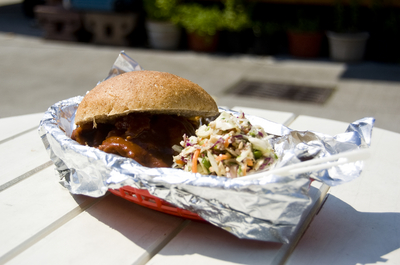
A barbecue tofu sandwich with a side of slaw from The Lunch Room, one of the vendors at Mark's Carts.
Joseph Tobianski | AnnArbor.com
4. A coordinated initiative to encourage major institutions to buy more local products. University of Michigan President Mary Sue Coleman announced last month that the university would get 20 percent of its food from Michigan sources by 2025.
One key opportunity that would accelerate Michigan’s agri-food industry is the development of basic food processing operations, said Kathryn Colasanti, leader of the Michigan Good Food Charter Development project and visiting specialist with MSU’s C.S. Mott Group for Sustainable Agriculture.
For example, universities, hospitals and prisons generally want to buy more local food. But they may not be positioned to prepare locally grown food for consumption, Colasanti said.
“They want the local product and fresh food but don’t always have the capacity to deal with 10, 20, 30 farmers to get it,” Colasanti said. “They need delivering, they need processing — just washing, cutting, chopping — before it gets to their door. That’s the sort of infrastructure that’s missing.”
She added: “There is a lot of economic opportunity because we have the demand from the buyers.”
That demand is crystal clear to local businesses like the Produce Station, which employed 65 workers this summer, up from 55 a year ago.
In late summer, the Produce Station, which is located just south of downtown on State Street, gets 60 percent to 70 percent of its products from local farmers, said general manager Andrew Gorsuch.
“We buy direct from farms for a lot of the things we sell,” he said.
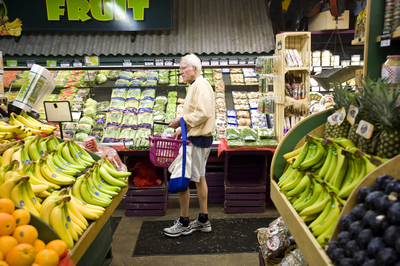
Ann Arbor resident Karl Gotting shops at the Produce Station.
Joseph Tobianski I AnnArbor.com
The Produce Station buys fruits, vegetables, dairy products and greenery from local farms.
“If we’re talking about a cheese-maker that has a herd of cows, they take the milk and make it into cheese, they sell it to us and we sell it to the customers,” Gorsuch said. “All that money is helping out the people of Michigan, and that’s a positive in my opinion. On the fruits and vegetables side, the same thing.”
Consumers’ interest in local products is even causing big-box stores like Michigan-based Meijer and global retailer Walmart to start buying more locally grown food — which presents a competitive problem for small local retailers.
For now, though, it’s not cutting into the Produce Station’s profits.
“I think business will be fine,” Gorsuch said. “We’ve had a great year so far.”
Meanwhile, local farmer's markets are flourishing, too. The Ann Arbor Farmers Market tested a Wednesday evening market this summer, and U-M tested a farmer's market at the Michigan Union last month.
The number of Michigan farms that sell products directly to consumers rose 29.4 percent to 6,373 from 2002 to 2007, according to an MSU report. Farmers sold $37.3 million in products directly to consumers in 2007, according to the report.
Meanwhile, the number of certified organic agriculture operations in Michigan rose from 171 in 2006 to 232 in 2007 and 256 in 2008, according to the U.S. Department of Agriculture's Economic Research Service. Callan said that an educational initiative to encourage local residents to buy more local food would be an instant boost to the economy.
A report by a group called the Food Systems Economic Partnership found that if residents on the eastern side of Washtenaw County were to spend 10 percent of their food budgets on local food, it would inject $34 million into the local economy.
“To foster and create more jobs and local pride, local sense of community, it’s a really achievable endeavor,” Callan said. “And I think it can be relatively pain-free. If I have a choice, a real choice of produce options and the local option is even 5 percent more, I’ll do it.”
Contact AnnArbor.com's Nathan Bomey at (734) 623-2587 or nathanbomey@annarbor.com. You can also follow him on Twitter or subscribe to AnnArbor.com's newsletters.


Comments
A2Susie
Sat, Oct 15, 2011 : 11:59 p.m.
Busches has lots of amazingly fresh, marked Michigan produce!
tommy_t
Sat, Oct 15, 2011 : 11:33 p.m.
Farming, the future American growth horizon. Best to learn the trade - at this rate you will soon be farming the backyard again.
russellr
Sat, Oct 15, 2011 : 5:06 p.m.
I say yes buy local, the only problem with that is Ann Abor is the worst offender in not buying local. I see more foreign cars here than anywhere!!!! You want to talk about keeping the money in Michigan and not sending it to Japan, Korea, Germany. This is where the money goes when you buy a foreign car. So wake up it's not just buying produce here. Keep American jobs here in Michigan. You say not always American, some car parts come from Canada, Mexico. Yes that is true but the majority of profitts stay here not oversees!!!
Dog Guy
Sat, Oct 15, 2011 : 4:33 p.m.
How much would buying locally made vehicles (not those with imported engines, transmissions, electronics, engineering, etc.) inject into the local economy? What a shame that "Buy Local" stickers don't adhere to American cars and trucks!
arborani
Sat, Oct 15, 2011 : 3:06 p.m.
I routinely wash all produce (for home use) anyway, but am frequently annoyed with the totally unwashed condition of produce from some local groceries. Clumps of mud still clinging, grit even *inside* green onions, for example, when a simple hosing would make all the difference - at least to me.
Stephen Lange Ranzini
Sat, Oct 15, 2011 : 2:56 p.m.
Hoop houses, which extend the local growing season six weeks at beginning and end each year could add over 10,000 well paying jobs in Michigan if widely deployed according to researchers and economists at MSU ag extension. Hoop houses cost under $10,000 and produce a 20% annual return on investment according to MSU's experience over the past decade. Non-profit local food advocate Selma Cafe is taking a leading role in our area in evangelizing hoop house construction and University Bank has partnered with them to offer an innovative loan program to fund those who want to build hoop houses.
bluehoo
Sat, Oct 15, 2011 : 1:28 p.m.
People who want to use their food dollars "wisely" need to rethink just buying cheap. Meijers and Walmart produce prices doesn't show the true cost of their food. Or even come close to paying the farmer a living wage. Americans spend a far lower percentage of their income on food today than 20-50 years ago--yet we think food is "expensive." It's because we've become lulled into the processed, big cooperative vision of what our food should be (and the resulting disease-prone, not tasty, and often not even healthy product). I buy almost exclusively through farmer's mkts and CSAs--and yes, pay more money. But I know the food is safe, tastes good, and the people who are growing it are getting paid what they should be.
thehawk
Sun, Oct 16, 2011 : 12:38 a.m.
So I should just buy less food with my finite dollars? Yeah, that makes sense. i just won't eat at the end of the week, but I will have supported those farmers! I understand what you are saying, but I already don't have a home phone, no cable TV, I don't take vacations, I don't buy furniture or new clothes. I can't cut more corners to spend more on food, there are no more corners to cut. I'm happy for you that you are in a position to support the CSAs and farmer's markets.
Amber Coleman
Sat, Oct 15, 2011 : 7:50 p.m.
You've got to be kidding no food prices show the actual cost. Even organic locally grown food is still harvested by contract workers who do not get paid what they should. They are allowed to be paid by the pound for what they collect. Also most small local farms are not subject to minimum wage requirements and the child labor laws for agriculture are quite lax. Just visit a Michigan blueberry farm. Rows and rows of migrant workers and their children picking.
KJMClark
Sat, Oct 15, 2011 : 12:50 p.m.
Colasanti said. "They need delivering, they need processing — just washing, cutting, chopping — before it gets to their door. That's the sort of infrastructure that's missing." I don't quite get this. Let's say you want 20# of carrots. The delivery part is OK, but wouldn't the recipient want to wash, cut, and/or chop those carrots? I can understand that some people don't want the carrots to look like they just came out of the ground, but aren't you going to wash them yourself anyway? When I worked in food service (not briefly enough), we got heads of lettuce, whole carrots, etc, and processed them in the restaurant. Does that mean that the universities, hospitals, and prisons don't process the food at all? Don't they cook dishes? Is it all catered now? Things have gotten so industrial.
KJMClark
Sun, Oct 16, 2011 : 12:33 p.m.
Thanks, that was the impression I got. So, what they're saying is, "We want local produce, but we want it packaged up like Sysco does." Or, in reality, the universities, hospitals, and prisons want Sysco to buy locally, so they can check off that box and make their Board of Directors happy. Why does "run it like a business" always turn into "fire as many people as possible, so the administrators can get paid more"?
Grace Singleton
Sat, Oct 15, 2011 : 1:29 p.m.
There's been a huge shift in the industry over the past 20 years, dumbing down the skill needed in commercial kitchens. Buying already cleaned, & cut produce allows less labor dollars to be spent in a restaurant in two ways- you have less hours of prep & you can pay less as there is less training & experience needed when you are getting everything in standard format, just heat & serve. You spend more on the base cost of food of course- but the theory is that you still spend lesson labor than the increased food cost. It not only shifts the labor around, you have less control over what you get in-(harder to tell what shape it was in before it was prepped), flavor usually suffers, & many people will note that nutrient content is less. hopefully a trend that will continue to be turned backwards.
Carole
Sat, Oct 15, 2011 : 12:34 p.m.
If we all work together, we can bring Michigan back by purchasing locally. And, I'm glad to see that some of the bigger stores are getting to see the picture -- purchase local to sell local stuff. The Farmers Market also offers many fresh fruits and veggies for a reasonable cost. Let's bring Michigan back.
thehawk
Sat, Oct 15, 2011 : 12:02 p.m.
I would love to shop places like the Produce Station, but their prices are outrageous. I only have so many dollars to spend, and I have to use them wisely, so instead I shop at Meijer. I'm very happy to see Meijer trying to buy more locally! I'm so tired of buying too-green in-season fruits that rot before they are edible, and vegetables that are from who knows where.